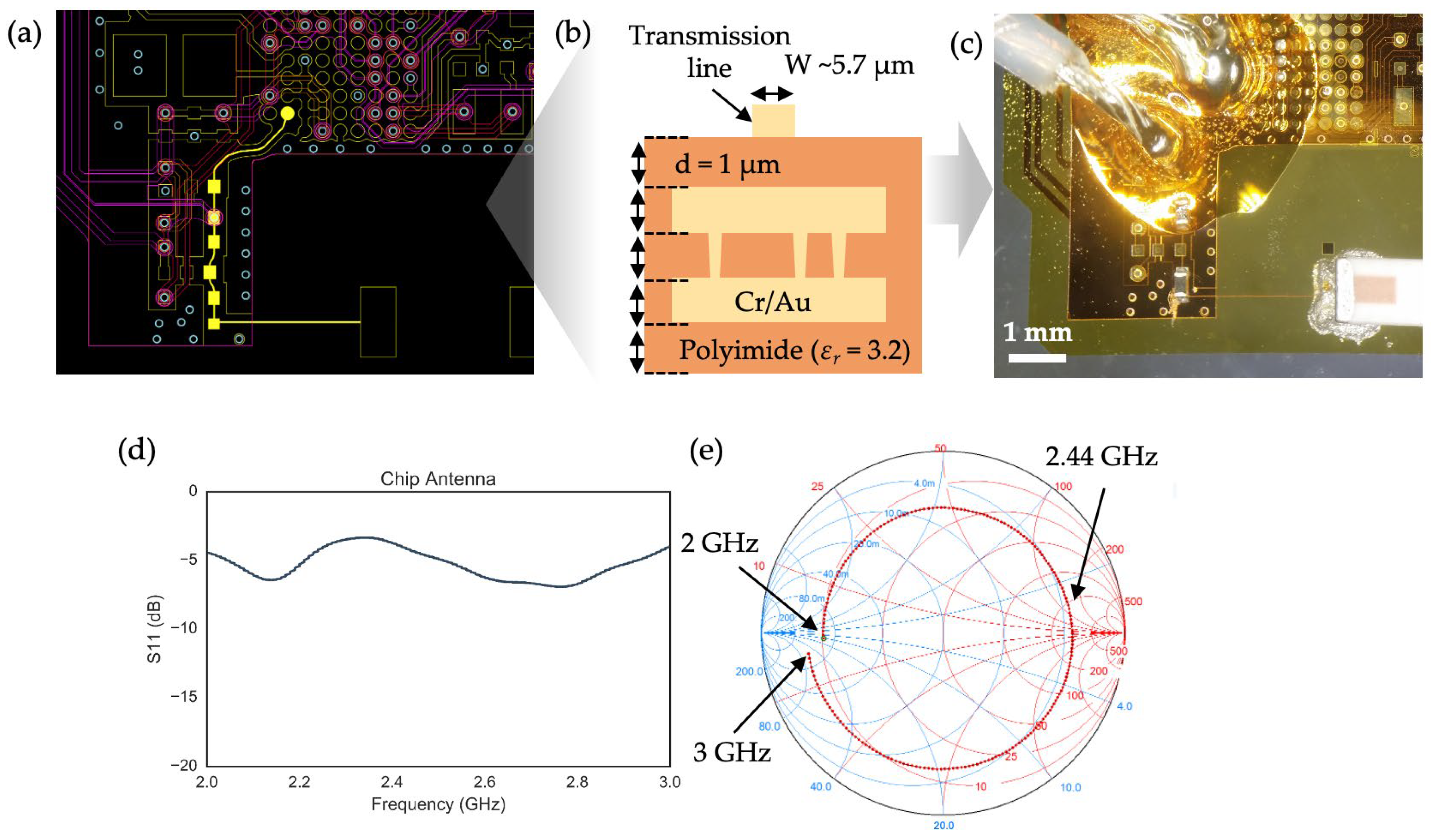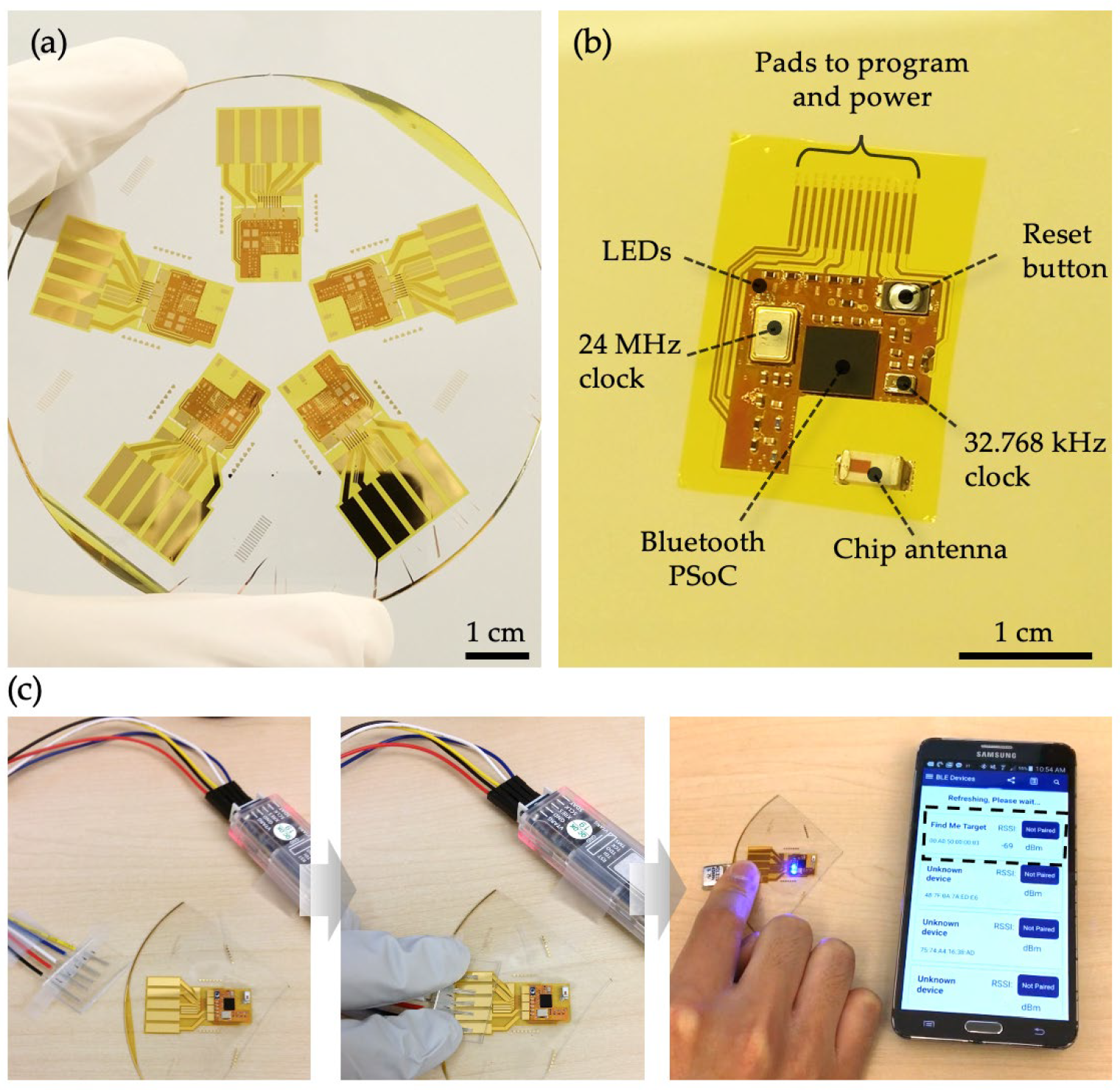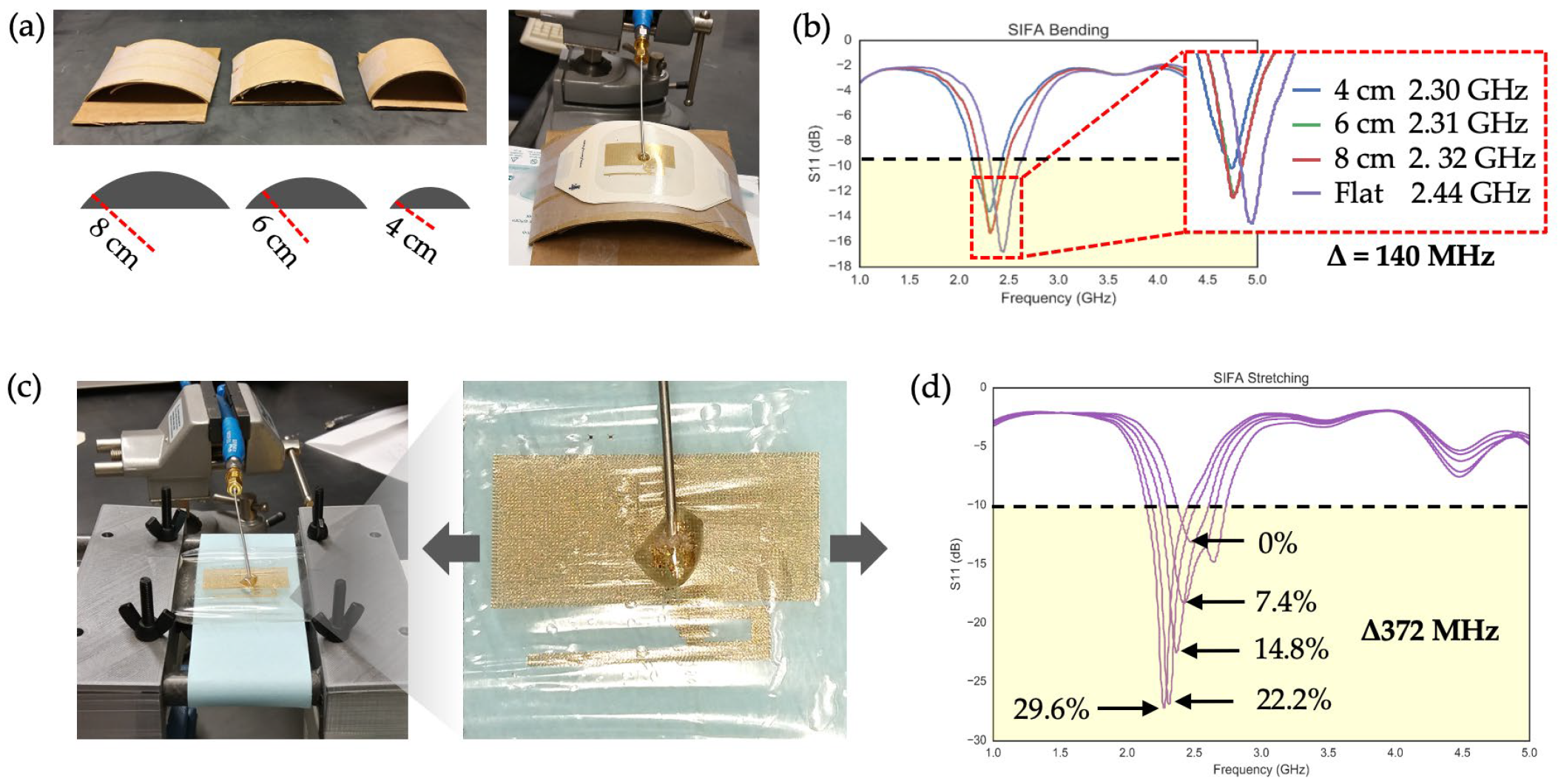A Wireless Smart Adhesive Integrated with a Thin-Film Stretchable Inverted-F Antenna
Abstract
1. Introduction
| Systems | Refs. | Entire Electronics Mounted Directly on the Skin? | Uses a Thin-Film Stretchable Antenna? | Demonstrate Use Cases in Free-Living Conditions? |
|---|---|---|---|---|
| Patch-type wearables for medical use | Commercial single-lead ECG patches | No. Encased in a rigid module. | No. Antennas are integrated within the modules. | Yes. |
| Prototypes based on thin elements directly mounted on the skin | [12,13,14,15,22,23] | No. Rely on an external connection to circuits. | No. | No. Only in controlled settings. |
| Prototypes based on soft materials | [9,24,25,26] | No. Only the sensor elements contact the skin. | No. Stretchable antennas are based on thick, printed materials or liquid metals. | No. Only in controlled settings. |
| S4 | This work and [16] | Yes. | Yes. | Yes. |
| Form Factors | Refs. | Dimensions (w × l × h in mm) 1 | Demonstrate On-Body Applications? | Integrated as Part of a Standalone Device? | Demonstrate to Use Cases in Free-Living Conditions? |
|---|---|---|---|---|---|
| Rigid film | [18] | 19 × 21 × 1.6 | No | No | No |
| Flexible film | [17] | 28 × 33 × 0.168 2 | No | No | No |
| Flexible film | [27] | 83 × 89 × 1.52 | No | No | No |
| Flexible film | [28] | 30 × 20 × 0.05 | Yes | No | No |
| Liquid metal (flexible) | [29] | 15 × 15 × 0.81 | No | No | No |
| Liquid metal (stretchable) | [30] | 6 × 40 × 1.6 | No | No | No |
| Stretchable film | [31] | 36 × 36 × 2 | Yes | No | No |
| Stretchable film | [32] | 5 × 46 × 0.2, 22 × 25 × 2 | Yes | No | No |
| Stretchable film | This work | 26 × 36 × 0.006 | Yes | Yes | Yes |
2. Design, Fabrication, and Characterization of a SIFA-Integrated S4 with Bluetooth Capabilities
2.1. Design and Fabrication of Thin-Film Transmission Lines
2.2. Implementation of a Bluetooth-Enabled S4
2.3. Development of a Stretchable Inverted-F Antenna (SIFA)
2.3.1. Ground Length Optimization
2.3.2. Fabrication and Optimization of a SIFA
2.3.3. Effects of Bending and Stretching of a SIFA
2.3.4. Effects of On-Body Applications on a SIFA
3. Axillary Temperature Monitoring with an S4-BLE Device Integrated with a SIFA
4. Discussion
5. Conclusions
Author Contributions
Funding
Institutional Review Board Statement
Informed Consent Statement
Data Availability Statement
Conflicts of Interest
References
- Vijayan, V.; Connolly, J.P.; Condell, J.; McKelvey, N.; Gardiner, P. Review of Wearable Devices and Data Collection Considerations for Connected Health. Sensors 2021, 21, 5589. [Google Scholar] [CrossRef] [PubMed]
- González Ramírez, M.L.; García Vázquez, J.P.; Rodríguez, M.D.; Padilla-López, L.A.; Galindo-Aldana, G.M.; Cuevas-González, D. Wearables for Stress Management: A Scoping Review. Healthcare 2023, 11, 2369. [Google Scholar] [CrossRef] [PubMed]
- Seçkin, A.Ç.; Ateş, B.; Seçkin, M. Review on Wearable Technology in Sports: Concepts, Challenges and Opportunities. Appl. Sci. 2023, 13, 10399. [Google Scholar] [CrossRef]
- Duncker, D.; Ding, W.Y.; Etheridge, S.; Noseworthy, P.A.; Veltmann, C.; Yao, X.; Bunch, T.J.; Gupta, D. Smart Wearables for Cardiac Monitoring—Real-World Use beyond Atrial Fibrillation. Sensors 2021, 21, 2539. [Google Scholar] [CrossRef]
- Zou, Y.; Chu, Z.; Guo, J.; Liu, S.; Ma, X.; Guo, J. Minimally invasive electrochemical continuous glucose monitoring sensors: Recent progress and perspective. Biosens. Bioelectron. 2023, 225, 115103. [Google Scholar] [CrossRef]
- Hurkmans, J.F.G.M.; Boddé, H.E.; Van Driel, L.M.J.; Van Doorne, H.; Junginger, H.E. Skin irritation caused by transdermal drug delivery systems during long-term (5 days) application. Br. J. Dermatol. 1985, 112, 461–467. [Google Scholar] [CrossRef]
- Tessier, A.; Zhuo, S.; Kabiri Ameri, S. Ultrasoft Long-Lasting Reusable Hydrogel-Based Sensor Patch for Biosignal Recording. Biosensors 2024, 14, 405. [Google Scholar] [CrossRef]
- Das, P.S.; Park, J.-Y. A flexible touch sensor based on conductive elastomer for biopotential monitoring applications. Biomed Signal Proces 2017, 33, 72–82. [Google Scholar] [CrossRef]
- Lee, S.M.; Byeon, H.J.; Lee, J.H.; Baek, D.H.; Lee, K.H.; Hong, J.S.; Lee, S.H. Self-adhesive epidermal carbon nanotube electronics for tether-free long-term continuous recording of biosignals. Sci. Rep. 2014, 4, 6074. [Google Scholar] [CrossRef]
- Yoon, I.S.; Oh, Y.; Kim, S.H.; Choi, J.; Hwang, Y.; Park, C.H.; Ju, B.-K. 3D Printing of Self-Wiring Conductive Ink with High Stretchability and Stackability for Customized Wearable Devices. Adv. Mater. Technol. 2019, 4, 1900363. [Google Scholar] [CrossRef]
- Ko, Y.; Oh, J.; Park, K.T.; Kim, S.; Huh, W.; Sung, B.J.; Lim, J.A.; Lee, S.-S.; Kim, H. Stretchable Conductive Adhesives with Superior Electrical Stability as Printable Interconnects in Washable Textile Electronics. ACS Appl. Mater. Inter. 2019, 11, 37043–37050. [Google Scholar] [CrossRef] [PubMed]
- Kim, D.-H.; Lu, N.; Ma, R.; Kim, Y.-S.; Kim, R.-H.; Wang, S.; Wu, J.; Won, S.M.; Tao, H.; Islam, A.; et al. Epidermal electronics. Science 2011, 333, 838–843. [Google Scholar] [CrossRef] [PubMed]
- Yeo, W.H.; Kim, Y.S.; Lee, J.; Ameen, A.; Shi, L.; Li, M.; Wang, S.; Ma, R.; Jin, S.H.; Kang, Z. Multifunctional epidermal electronics printed directly onto the skin. Adv. Mater. 2013, 25, 2773–2778. [Google Scholar] [CrossRef]
- Kabiri Ameri, S.; Ho, R.; Jang, H.; Tao, L.; Wang, Y.; Wang, L.; Schnyer, D.M.; Akinwande, D.; Lu, N. Graphene electronic tattoo sensors. ACS Nano 2017, 11, 7634–7641. [Google Scholar] [CrossRef] [PubMed]
- Jang, H.; Sel, K.; Kim, E.; Kim, S.; Yang, X.; Kang, S.; Ha, K.-H.; Wang, R.; Rao, Y.; Jafari, R.; et al. Graphene e-tattoos for unobstructive ambulatory electrodermal activity sensing on the palm enabled by heterogeneous serpentine ribbons. Nat. Commun. 2022, 13, 6604. [Google Scholar] [CrossRef] [PubMed]
- Kim, Y.-S.; Lu, J.; Shih, B.; Gharibans, A.; Zou, Z.; Matsuno, K.; Aguilera, R.; Han, Y.; Meek, A.; Xiao, J.; et al. Scalable Manufacturing of Solderable and Stretchable Physiologic Sensing Systems. Adv. Mater. 2017, 29, 1701312. [Google Scholar] [CrossRef]
- Awan, W.A.; Hussain, N.; Le, T.T. Ultra-thin flexible fractal antenna for 2.45 GHz application with wideband harmonic rejection. AEU—Int. J. Electron. Commun. 2019, 110, 152851. [Google Scholar] [CrossRef]
- Hussain, M.; Islam, T.; Alzaidi, M.S.; Elkamchouchi, D.H.; Alsunaydih, F.N.; Alsaleem, F.; Alhassoon, K. Single iterated fractal inspired UWB antenna with reconfigurable notch bands for compact electronics. Heliyon 2023, 9, e21419. [Google Scholar] [CrossRef]
- Huang, Y.; Xing, L.; Song, C.; Wang, S.; Elhouni, F. Liquid Antennas: Past, Present and Future. IEEE Open J. Antennas Propag. 2021, 2, 473–487. [Google Scholar] [CrossRef]
- Haj-Omar, A.; Thompson, W.L.; Kim, Y.S.; Coleman, T.P. Adaptive flexible antennas for wireless biomedical applications. In Proceedings of the 2016 IEEE 17th Annual Wireless and Microwave Technology Conference (WAMICON), Clearwater, FL, USA, 11–13 April 2016; pp. 1–3. [Google Scholar]
- Haj-Omar, A.; Thompson, W.L.; Kim, Y.S.; Glick, P.; Tolley, M.; Coleman, T.P. Stretchable and Flexible Adhesive-Integrated Antenna for Biomedical Applications. In Proceedings of the 2016 IEEE International Symposium on Antennas and Propagation (APSURSI), Fajardo, PR, USA, 26 June–1 July 2016; pp. 459–460. [Google Scholar]
- Ferrari, L.M.; Sudha, S.; Tarantino, S.; Esposti, R.; Bolzoni, F.; Cavallari, P.; Cipriani, C.; Mattoli, V.; Greco, F. Ultraconformable Temporary Tattoo Electrodes for Electrophysiology. Adv. Sci. 2018, 5, 1700771. [Google Scholar] [CrossRef]
- Koo, J.H.; Jeong, S.; Shim, H.J.; Son, D.; Kim, J.; Kim, D.C.; Choi, S.; Hong, J.-I.; Kim, D.-H. Wearable Electrocardiogram Monitor Using Carbon Nanotube Electronics and Color-Tunable Organic Light-Emitting Diodes. ACS Nano 2017, 11, 10032–10041. [Google Scholar] [CrossRef] [PubMed]
- Zhao, D.; Zhao, J.; Liu, L.; Guo, W.; Zhu, K.; Yang, G.; Li, Z.; Wu, H. Flexible Hybrid Integration Enabled xsOn-Skin Electronics for Wireless Monitoring of Electrophysiology and Motion. IEEE Trans. Biomed. Eng. 2022, 69, 1340–1348. [Google Scholar] [CrossRef] [PubMed]
- Jeong, Y.R.; Kim, J.; Xie, Z.; Xue, Y.; Won, S.M.; Lee, G.; Jin, S.W.; Hong, S.Y.; Feng, X.; Huang, Y.; et al. A skin-attachable, stretchable integrated system based on liquid GaInSn for wireless human motion monitoring with multi-site sensing capabilities. NPG Asia Mater. 2017, 9, e443. [Google Scholar] [CrossRef]
- Maranha, M.; Silva, A.F.; Lopes, P.A.; de Almeida, A.T.; Tavakoli, M. Digitally Printed Liquid Metal Composite Antenna for Energy Harvesting: Toward Energy-Autonomous Battery-Free Wearable Bioelectronics. Adv. Sens. Res. 2023, 2, 2200025. [Google Scholar] [CrossRef]
- Saeed, S.M.; Balanis, C.A.; Birtcher, C.R.; Durgun, A.C.; Shaman, H.N. Wearable Flexible Reconfigurable Antenna Integrated With Artificial Magnetic Conductor. IEEE Antennas Wirel. Propag. Lett. 2017, 16, 2396–2399. [Google Scholar] [CrossRef]
- Särestöniemi, M.; Sonkki, M.; Myllymäki, S.; Pomalaza-Raez, C. Wearable Flexible Antenna for UWB On-Body and Implant Communications. Telecom 2021, 2, 285–301. [Google Scholar] [CrossRef]
- Wang, C.; Yeo, J.C.; Chu, H.; Lim, C.T.; Guo, Y.X. Design of a Reconfigurable Patch Antenna Using the Movement of Liquid Metal. IEEE Antennas Wirel. Propag. Lett. 2018, 17, 974–977. [Google Scholar] [CrossRef]
- Yao, B.; Xu, X.; Zhang, Q.; Yu, H.; Li, H.; Ren, L.; Perini, S.; Lanagan, M.; Wang, Q.; Wang, H. Highly stretchable and mechanically tunable antennas based on three-dimensional liquid metal network. Mater Lett 2020, 270, 127727. [Google Scholar] [CrossRef]
- Chang, T.; Tanabe, Y.; Wojcik, C.C.; Barksdale, A.C.; Doshay, S.; Dong, Z.Y.; Liu, H.; Zhang, M.Y.; Chen, Y.L.; Su, Y.W.; et al. A General Strategy for Stretchable Microwave Antenna Systems using Serpentine Mesh Layouts. Adv. Funct. Mater. 2017, 27, 1703059. [Google Scholar] [CrossRef]
- Kim, Y.-S.; Basir, A.; Herbert, R.; Kim, J.; Yoo, H.; Yeo, W.-H. Soft Materials, Stretchable Mechanics, and Optimized Designs for Body-Wearable Compliant Antennas. ACS Appl. Mater. Interfaces 2020, 12, 3059–3067. [Google Scholar] [CrossRef]
- Visser, H.J. Antenna Theory and Applications; John Wiley & Sons Ltd.: Chichester, West Sussex, UK, 2012. [Google Scholar]
- Wessendorf, A.M.; Newman, D.J. Dynamic understanding of human-skin movement and strain-field analysis. IEEE Trans. Biomed. Eng. 2012, 59, 3432–3438. [Google Scholar] [CrossRef] [PubMed]
- Vallozzi, L.; Pepe, D.; Castel, T.; Rogier, H.; Zito, D. On-Body Characterization of Planar Differential Antennas for Multiple, Wide, and Narrow Bands. Int. J. Antennas Propag. 2016, 2016, 7439403. [Google Scholar] [CrossRef]
- See, T.S.P.; Chen, Z.N. Experimental Characterization of UWB Antennas for On-Body Communications. IEEE Trans. Antennas Propag. 2009, 57, 866–874. [Google Scholar] [CrossRef]
- Tuovinen, T.; Kumpuniemi, T.; Yazdandoost, K.Y.; Hämäläinen, M.; Iinatti, J. Effect of the antenna-human body distance on the antenna matching in UWB WBAN applications. In Proceedings of the 2013 7th International Symposium on Medical Information and Communication Technology (ISMICT), Tokyo, Japan, 6–8 March 2013; pp. 193–197. [Google Scholar]
- Hall, K.L.; Streeter, R.; Popović, Z. Near-Field Antenna for Noninvasive Human Head Microwave Thermometry. In Proceedings of the 2022 IEEE International Symposium on Antennas and Propagation and USNC-URSI Radio Science Meeting (AP-S/URSI), Denver, CO, USA, 10–15 July 2022; pp. 880–881. [Google Scholar]
- Ding, S.; Pichon, L. Sensitivity Analysis of an Implanted Antenna within Surrounding Biological Environment. Energies 2020, 13, 996. [Google Scholar] [CrossRef]
- Technology, J. Understanding Chip Antennas. Available online: https://www.johansontechnology.com/tech-notes/understanding-chip-antennas/ (accessed on 23 October 2024).
- Ubale, V.S.; Lamba, O. Performance Evaluation of Wearable Antennas for Body Area Network Applications. Webology 2021, 18, 1724–1741, ISSN: 1735-188X. [Google Scholar]
- Hashim, F.F.; Mahadi, W.N.L.B.; Abdul Latef, T.B.; Othman, M.B. Key Factors in the Implementation of Wearable Antennas for WBNs and ISM Applications: A Review WBNs and ISM Applications: A Review. Electronics 2022, 11, 2470. [Google Scholar] [CrossRef]
- Kim, C.; Jang, A.; Kim, S.; Cho, S.; Lee, D.; Kim, Y.J. A Wearable ECG Monitoring System Using Microneedle Electrodes for Small Animals. IEEE Sens. J. 2023, 23, 21873–21881. [Google Scholar] [CrossRef]
- Kim, H.; Kwon, Y.T.; Zhu, C.; Wu, F.; Kwon, S.; Yeo, W.H.; Choo, H.J. Real-Time Functional Assay of Volumetric Muscle Loss Injured Mouse Masseter Muscles via Nanomembrane Electronics. Adv. Sci. 2021, 8, e2101037. [Google Scholar] [CrossRef]







Disclaimer/Publisher’s Note: The statements, opinions and data contained in all publications are solely those of the individual author(s) and contributor(s) and not of MDPI and/or the editor(s). MDPI and/or the editor(s) disclaim responsibility for any injury to people or property resulting from any ideas, methods, instructions or products referred to in the content. |
© 2024 by the authors. Licensee MDPI, Basel, Switzerland. This article is an open access article distributed under the terms and conditions of the Creative Commons Attribution (CC BY) license (https://creativecommons.org/licenses/by/4.0/).
Share and Cite
Chhetry, A.; Kim, H.; Kim, Y.S. A Wireless Smart Adhesive Integrated with a Thin-Film Stretchable Inverted-F Antenna. Sensors 2024, 24, 7155. https://doi.org/10.3390/s24227155
Chhetry A, Kim H, Kim YS. A Wireless Smart Adhesive Integrated with a Thin-Film Stretchable Inverted-F Antenna. Sensors. 2024; 24(22):7155. https://doi.org/10.3390/s24227155
Chicago/Turabian StyleChhetry, Ashok, Hodam Kim, and Yun Soung Kim. 2024. "A Wireless Smart Adhesive Integrated with a Thin-Film Stretchable Inverted-F Antenna" Sensors 24, no. 22: 7155. https://doi.org/10.3390/s24227155
APA StyleChhetry, A., Kim, H., & Kim, Y. S. (2024). A Wireless Smart Adhesive Integrated with a Thin-Film Stretchable Inverted-F Antenna. Sensors, 24(22), 7155. https://doi.org/10.3390/s24227155









